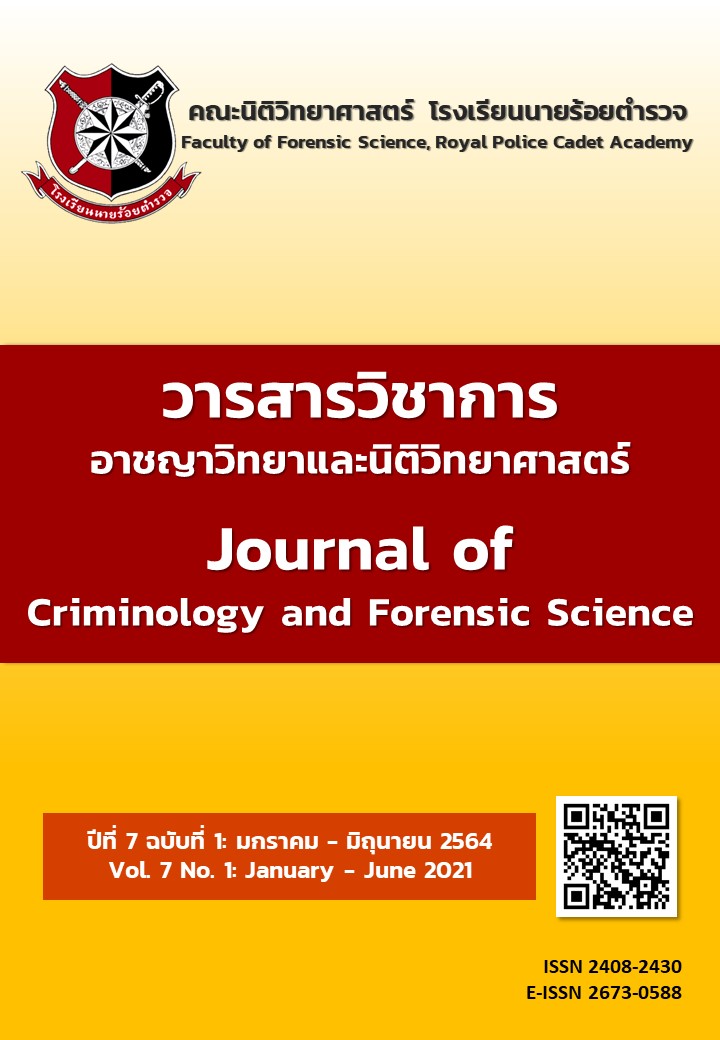การศึกษาแนวทางการตรวจพิสูจน์หลักฐานทางดิจิทัลในงานนิติวิทยาศาสตร์
Main Article Content
บทคัดย่อ
ปัจจุบันอุปกรณ์ดิจิทัลมีการใช้งานกันอย่างแพร่หลายในชีวิตประจำวันของมนุษย์ทำให้อัตราการเกิดเหตุอาชญากรรมบนระบบออนไลน์มีเพิ่มมากยิ่งขึ้น ดังนั้นขั้นตอนหรือแนวทางการตรวจพิสูจน์หลักฐานที่เกี่ยวข้องกับอุปกรณ์ดิจิทัลจึงต้องมีความซับซ้อนและความน่าเชื่อถือสูงขึ้นเช่นเดียวกัน งานวิจัยเรื่องนี้จึงมีวัตถุประสงค์เพื่อศึกษาแนวทางการตรวจพิสูจน์หลักฐานทางดิจิทัลในงานนิติวิทยาศาสตร์ของประเทศไทย โดยเป็นการศึกษาเชิงคุณภาพซึ่งแบ่งออกเป็น 2 ส่วน ส่วนแรกเป็นการศึกษาเอกสารแนวทางการตรวจพิสูจน์หลักฐานทางดิจิทัลของหน่วยงานทั้งภายในและภายนอกประเทศจำนวน 4 หน่วยงาน ได้แก่ 1) สำนักงานพัฒนาธุรกรรมทางอิเล็กทรอนิกส์ 2) สถาบันมาตรฐานและเทคโนโลยีแห่งชาติ 3) คณะทำงานวิทยาศาสตร์เกี่ยวกับหลักฐานดิจิทัล และ 4) องค์การมาตรฐานสากล ส่วนที่สองเป็นการสัมภาษณ์เชิงลึกจากผู้ให้ข้อมูลหลักในหน่วยงานทางด้านนิติวิทยาศาสตร์ของประเทศไทยจำนวน 4 หน่วยงาน ได้แก่ 1) กองบังคับการปราบปรามการกระทำความผิดเกี่ยวกับอาชญากรรมทางเทคโนโลยี 2) สถาบันนิติวิทยาศาสตร์ 3) กรมสอบสวนคดีพิเศษ และ 4) สำนักงานพิสูจน์หลักฐานตำรวจ ผลการศึกษาเอกสารสามารถสรุปขั้นตอนการตรวจพิสูจน์หลักฐานทางดิจิทัลออกเป็น 9 ขั้นตอนและ ผลการสัมภาษณ์ผู้ให้ข้อมูลหลักทำให้เห็นถึงสภาพปัญหาในขั้นตอนการตรวจพิสูจน์หลักฐาน เช่น การไม่เข้าใจถึงวัตถุประสงค์ในการส่งตรวจพิสูจน์และการขาดองค์ความรู้และความเชี่ยวชาญของผู้ปฏิบัติงาน งานวิจัยเรื่องนี้สามารถนำไปใช้พัฒนาเป็นมาตรฐานการตรวจพิสูจน์หลักฐานทางดิจิทัลของประเทศไทยได้ในอนาคต
Article Details
เนื้อหาและข้อมูลในบทความที่ลงตีพิมพ์ใน วารสารวิชาการอาชญาวิทยาและนิติวิทยาศาสตร์ โรงเรียนนายร้อยตำรวจ ถิอว่าเป็นข้อคิดเห็นและความรั้บผิดชอบของผู้เขียนบทความโดยตรงซึ่งกองบรรณาธิการวารสาร ไม่จำเป็นต้องเห็นด้วยหรือรับผิดชอบใดๆ
บทความ ข้อมูล เนื้อหา รูปภาพ ฯลฯ ที่ได้รับการตีพิมพ์ใน วารสารวิชาการอาชญาวิทยาและนิติวิทยาศาสตร์ ถือว่าเป็นลิขสิทธิ์ของวารสาร วารสารวิชาการอาชญาวิทยาและนิติวิทยาศาสตร์ หากบุคคลหรือหน่วยงานใดต้องการนำทั้งหมดหรือส่วนหนึ่งส่วนใดไปเผยแพร่ต่อหรือเพื่อกระทำการใดๆ จะต้องได้รับอนุญาตเป็นลายลักษณ์อักษรจาก วารสารวิชาการอาชญาวิทยาและนิติวิทยาศาสตร์ ก่อนเท่านั้น
เอกสารอ้างอิง
British Standard. (2016). Information Technology – Security Technology – Guidelines for Identification, Collection, Acquisition and Preservation of Digital Evidence (ISO/IEC 27037:2012. London: The British Standards Institution.
Chairangsinant, C. (2559). International Standards Accreditation for Forensic science. Journal of Criminology and Forensic Science, 2(1), 60-71. (In Thai).
Casey, E. (2011). Digital evidence and computer crime: forensic science, computers and the internet. 3rd ed. The United States of America: British Library.
Electronic Transactions Development Agency (Public Organization). (2018). Thailand Internet User Profile 2018. Huai Khwang: Electronic Transactions Development Agency (Public Organization).
Grobler, M. (2010). Digital Forensic Standards: International Progress. Proceedings of the South African Information Security Multi-Conference (SAISMC 2010). 261- 271.
Horsman, G. (2019). Formalising investigative decision making in digital forensics: Proposing the Digital Evidence Reporting and Decision Support (DERDS) framework. Digital Investigation, 28, 146-151.
Kent, K., Chevalier, S, Grance, T, and Dang, H. (2006). NIST Special Publication 800-86 Guide to Integrating Forensic Techniques into Incident Response. Gaithersburg: National Institute of Standards and Technology.
Mumba, E. R. and Venter, H. (2014). Testing and Evaluating the Harmonized Digital Forensic Investigation Process in Post Mortem Digital Investigations. ADFSL Conference on Digital Forensics, Security and Law, 83-97.
Nassif, L. N. (2017). Towards a Proof Acceptance by Overcoming Challenges in Collecting Digital Evidence. International Science Index, Law and Political Sciences. 11(1), 240-243.
National Statistical Office. (2018). Survey of the use of information and communication technology in the household 2018 (Q1). Lak Si: National Statistical Office. (In Thai).
Scientific Working Group on Digital Evidence (SWGDE). (2014). SWGDE Best Practices for Computer Forensics Version 3.1.
Suriyawongkul, A. (2015). Digital evidence is everywhere. How to manage it reliably. Retrieved 15 September 2019, from https://thainetizen.org/2015/07/digital-forensics-workshop/. (In Thai).
Thailand Computer Emergency Response Team (ThaiCERT) of Electronic Transactions Development Agency (Public Organization). (2020). Threat statistics. Retrieved 12 February 2020, from https://www.thaicert.or.th/statistics/statistics.html. (In Thai).
Umberg, T. and Warden, C. (2013). Digital Evidence and Investigatory Protocols. Digital Evidence and Electronic Signature Law Review. 11, 128-136.
Working Group for Drafting Digital Forensic Examination Practice Standards. (2016). Recommendations for Digital Devices Management Standards in Forensic Examination. Huai Khwang: Digital Forensics Center of Electronic Transactions Development Agency (Public Organization). (In Thai).
Working Group for Drafting Digital Forensic Examination Practice Standards. (2018). Thailand Internet User Behavior 2018. Huai Khwang: Digital Forensics Center of Electronic Transactions Development Agency (Public Organization). (In Thai).


